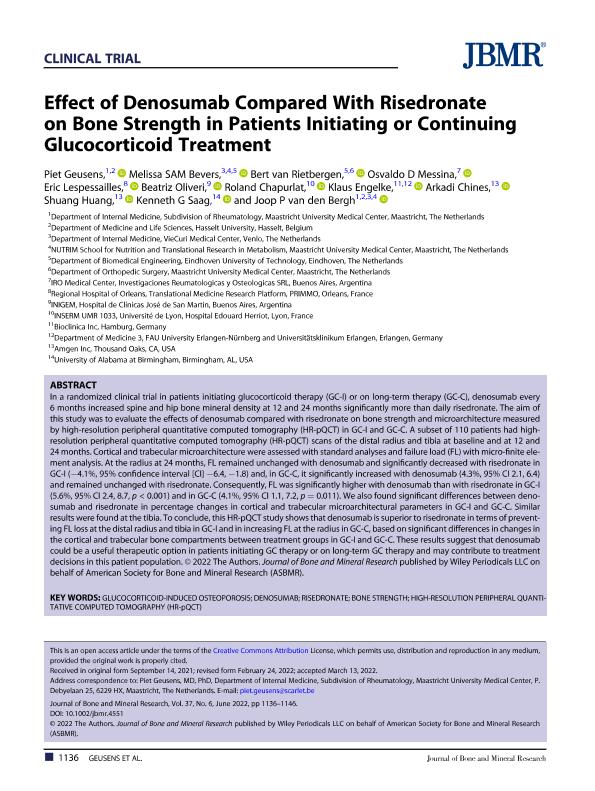Artículo
Effect of Denosumab Compared With Risedronate on Bone Strength in Patients Initiating or Continuing Glucocorticoid Treatment
Geusens, Piet; Bevers, Melissa S. A. M; van Rietbergen, Bert; Messina, Osvaldo D.; Lespessailles, Eric; Oliveri, María Beatriz ; Chapurlat, Roland; Engelke, Klaus; Chines, Arkadi; Huang, Shuang; Saag, Kenneth G.; van den Bergh, Joop P.
; Chapurlat, Roland; Engelke, Klaus; Chines, Arkadi; Huang, Shuang; Saag, Kenneth G.; van den Bergh, Joop P.
 ; Chapurlat, Roland; Engelke, Klaus; Chines, Arkadi; Huang, Shuang; Saag, Kenneth G.; van den Bergh, Joop P.
; Chapurlat, Roland; Engelke, Klaus; Chines, Arkadi; Huang, Shuang; Saag, Kenneth G.; van den Bergh, Joop P.
Fecha de publicación:
06/2022
Editorial:
American Society for Bone and Mineral Research
Revista:
Journal of Bone and Mineral Research
ISSN:
0884-0431
Idioma:
Inglés
Tipo de recurso:
Artículo publicado
Clasificación temática:
Resumen
In a randomized clinical trial in patients initiating glucocorticoid therapy (GC-I) or on long-term therapy (GC-C), denosumab every 6 months increased spine and hip bone mineral density at 12 and 24 months significantly more than daily risedronate. The aim of this study was to evaluate the effects of denosumab compared with risedronate on bone strength and microarchitecture measured by high-resolution peripheral quantitative computed tomography (HR-pQCT) in GC-I and GC-C. A subset of 110 patients had high-resolution peripheral quantitative computed tomography (HR-pQCT) scans of the distal radius and tibia at baseline and at 12 and 24 months. Cortical and trabecular microarchitecture were assessed with standard analyses and failure load (FL) with micro-finite element analysis. At the radius at 24 months, FL remained unchanged with denosumab and significantly decreased with risedronate in GC-I (−4.1%, 95% confidence interval [CI] −6.4, −1.8) and, in GC-C, it significantly increased with denosumab (4.3%, 95% CI 2.1, 6.4) and remained unchanged with risedronate. Consequently, FL was significantly higher with denosumab than with risedronate in GC-I (5.6%, 95% CI 2.4, 8.7, p < 0.001) and in GC-C (4.1%, 95% CI 1.1, 7.2, p = 0.011). We also found significant differences between denosumab and risedronate in percentage changes in cortical and trabecular microarchitectural parameters in GC-I and GC-C. Similar results were found at the tibia. To conclude, this HR-pQCT study shows that denosumab is superior to risedronate in terms of preventing FL loss at the distal radius and tibia in GC-I and in increasing FL at the radius in GC-C, based on significant differences in changes in the cortical and trabecular bone compartments between treatment groups in GC-I and GC-C. These results suggest that denosumab could be a useful therapeutic option in patients initiating GC therapy or on long-term GC therapy and may contribute to treatment decisions in this patient population.
Archivos asociados
Licencia
Identificadores
Colecciones
Articulos(INIGEM)
Articulos de INSTITUTO DE INMUNOLOGIA, GENETICA Y METABOLISMO
Articulos de INSTITUTO DE INMUNOLOGIA, GENETICA Y METABOLISMO
Citación
Geusens, Piet; Bevers, Melissa S. A. M; van Rietbergen, Bert; Messina, Osvaldo D.; Lespessailles, Eric; et al.; Effect of Denosumab Compared With Risedronate on Bone Strength in Patients Initiating or Continuing Glucocorticoid Treatment; American Society for Bone and Mineral Research; Journal of Bone and Mineral Research; 37; 6; 6-2022; 1136-1146
Compartir
Altmétricas



